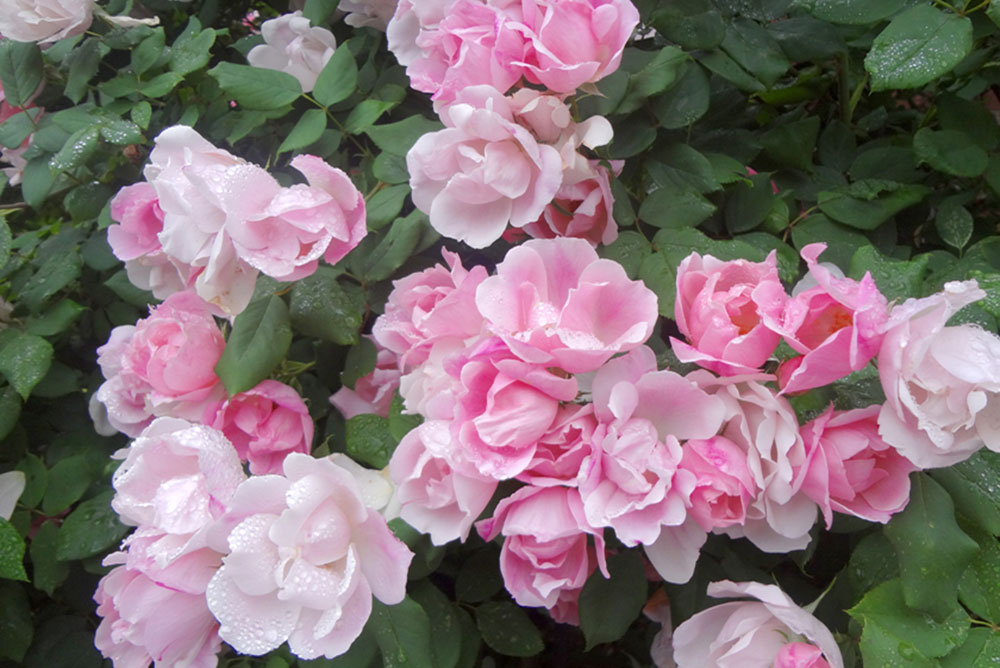
Roses captured last spring on a morning walk around Washington’s Capitol Hill. / Photo by Stephanie Cavanaugh.
I READ A LOT of magazines, though not those devoted to gardening, which just frustrate me with instructions that I will never follow.
Ideas, concepts, these I enjoy. Of course, most shelter magazines are full of gardens and garden ideas around this time of year, but I’ve never seen an issue so devoted to a floral theme as the March-April issue of Veranda.
The pages are packed with flowery thoughts for home, garden and even your body—think a $240 gardenia rejuvenating cream from http://www.sapeloskincare.com and a necklace of what look like stained-glass pansies by Siddharth Kasliwal, “price upon request,” which is never an encouraging line.
Among much else, there’s a section on trellis, or lattice, those crisscross strips of wood that instantly evoke gardens, whether or not you’ve trained roses or clematis to clamber and twine. Veranda shows treillage (to be haughty) attached to walls, freestanding in gardens, and decorating wallpaper, china, lamps and chairs—both frames and fabrics.
Ideas for its use that would transform the dreariest of spaces into a grotto or garden—without adding a single live plant. What would Versailles be without it? Think about that.
Another section of the magazine highlights florists and floral designs, with an emphasis on blousy, naturalistic British designs that include glorious weeds such as Queen Anne’s lace mingled with white lilacs and roses. Heady stuff.
It seems you start with a vase or vessel and “a framework of twigs,” poking stems here and there, building and playing, creating a garden in a pot. Ah, so simple they make it seem.
The homes and rooms, from kitchen to living room, to bedrooms and baths, are plastered with floral papers, draped with flowered fabrics—a periwinkle paper here, a rose chintz there—accessorized by more florals and gardenesque accents, like the pale green cachepot with pink dragonflies on the lid.
Designer Mario Buatta, dearly departed Prince of Chintz, plays a cameo role. A bedroom he designed wears sprightly green-and-white floral wallpaper and a soft pink ceiling—I would love a soft pink ceiling.
And then there are the gardens—but hold those secateurs. Yes, the weather is balmy, the sun shines, the daffodils are coming up fast and the forsythia is bursting with buds BUT April 21 is the last frost date for Washington, DC. If you’re anywhere north of me you’ll have to hold back even longer.
Of course you can risk tossing seeds about, and then watch their tender stems gasp and drop dead when the temperature again dips to freezing, probably tomorrow or the day after. Been there, done that. Sure, try it.
We’ve been fooled before. Two years ago another faux spring ruined a season’s worth of hydrangeas. Tragic.
And anyway, we still have months of tulips and the lollypop heads of alliums and the cherry trees yet to enjoy.
Don’t push it. Go sniff a hyacinth.
That said, it is time to start dreaming of hedges and ivy and topiaries mixed with lavender and orange and roses, roses and roses, of which Veranda highlights an enviable selection. As usual, I have fabulous plans.
As for roses. I confess I’ve given up attempting to grow anything but Knockout roses, a plant nearly impossible to kill that rather boringly spits out blossom after blossom from late spring until, in this last year’s case, late December. In a tiny garden like mine, with limited sun, more exotic varieties are an exercise in frustration.
Oh, but I miss the heady, voluptuous perfume of roses. Knockouts, while colorful and reliably disease resistant, are absolutely without fragrance, as are so many of the hybrid teas and climbers we see in gardens. It’s as if you’re peering at a lush garden with a clothespin on your nose.
“Big, voluptuous, wildly fragrant roses” are the subject of a whole section of the magazine. Fields of them in England and California. Old world roses with a variety of top and bottom notes such as clove and citrus and nutmeg. Ephemeral roses that grow droopy and soggy brown in heavy rains, leaves that fall off and squish underfoot. Just what you don’t want in a tiny garden.
On the other hand, why are we growing scentless roses when scent is pretty much the point of a rose? There are far more beautiful flowers that we can plant; they’re even fragrant.
One can always visit the US National Arboretum in Washington for an exquisite sensory experience among their treasured collection of old roses. If you’re lucky, the lilacs and peonies will be in bloom as well.
My mother grew some ramblers, red roses against the gray split-rail fence that surrounded the property. The scent was intoxicating. She’d send me to the last classes of the year with a posy wrapped in damp paper towel and tin foil for my 4th-grade, 5th-grade, 6th-grade teachers. These were, I think, little prayers that I’d at least get Cs in everything but reading, which was never a problem.
Speaking of reading, it’s time to dig up Henry Mitchell—the absolutely essential Earthman—and start considering spring,
—Stephanie Cavanaugh
LittleBird “Stephanie Gardens” tries to keep us from making the gardening mistakes she has made.
MyLittleBird often includes links to products we write about. Our editorial choices are made independently; nonetheless, a purchase made through such a link can sometimes result in MyLittleBird receiving a commission on the sale, whether through a retailer, an online store or Amazon.com.
